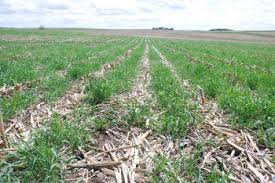As prices for land, water, inputs and equipment rise, good nutrient management on all fields becomes increasingly important to the bottom line. Manure and wastewater contain valuable nutrients that, if managed properly, can help meet crop nutrient needs and increase soil quality and fertility. The amount, timing, rate, and placement needs to be considered when manure or wastewater is applied.
Regulation 81 stipulates that “No application of manure or wastewater shall be made to a land application site at a rate that will exceed the capacity of the soil and the planned crops to assimilate plant available nitrogen within 12 months of the manure or wastewater being applied.” Lab testing of land application area soils, as well as manure and wastewater will reveal the amount of nutrients in each type of material. Using this information in concert with the expected nutrient needs of the planned crop, agronomic balance calculation can be made and the application rate determined.
A well-prepared Nutrient Management Plan (NMP) describes how manure and wastewater are managed. It includes how much gets generated annually at the facility, along with the acreage available for application and accompanying production area maps and soils information. An NMP will also include the types of crops and forage grown and corresponding yields, nutrient balance calculations for fields receiving manure, wastewater or compost, and the record-keeping system that is used to ensure that nutrients, such as nitrogen and phosphorus, are applied at a rate that matches crops needs. The plan will also include Nitrogen and Phosphorus Transport Risk Assessments for each field. We also model erosion on each field using USDA-NRCS RUSLE2 and WEPs modeling applications to give you a better handle on whether soil is being lost, built or sustained.
Annual maintenance of a Nutrient Management Plan includes doing the sampling and testing of land application field soils, manure, wastewater, irrigation water and compost (if applicable), and using this information to prepare agronomic balance sheets for all fields that will receive waste applications. The nutrient management plan should be kept up to date and be available for examination by regulators, and records must be kept on site for a minimum of five years.
When additional land is purchased or leased, or farming or irrigation practices change, the NMP should be updated to ensure regulatory compliance. This also helps ensure that your fields are getting the maximum benefit from the soil amendments being applied.
Monitoring soil health in land application fields is crucial to maximizing crop production. Part of our compliance management program includes tracking soil health parameters from year to year and meeting with customers periodically to go over land application field soil fertility conditions. We focus on helping you build and improve soil health in order to reduce the need for costly fertilizer and pesticide inputs.
If it’s time to update your existing Nutrient Management (NMP) or Facility Management Plan (FMP), or you need a new one, please contact us at 720-887-9944. Brink, Inc. is a certified TSP and Conservation Planner, so if you’ve been approved for EQIP cost-share for a 590 NMP or some other practice, we can perform the design, installation and checkout. Typically the only out-of-pocket costs to the producer are the sampling and laboratory testing costs.
Services:
- New and Updated Nutrient Management Plans (NMP)
- New and Updated Facility Management Plans (FMP)
- Sampling and Testing
- Crop and land application record-keeping and database management
- Soil fertility improvement recommendations
- Soil loss modeling (RUSLE2, WEPs)
- Nitrogen & Phosphorus Transport Risk Assessment

